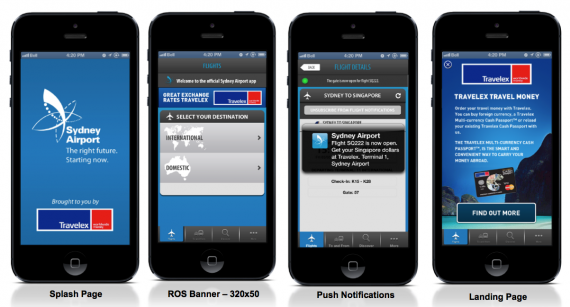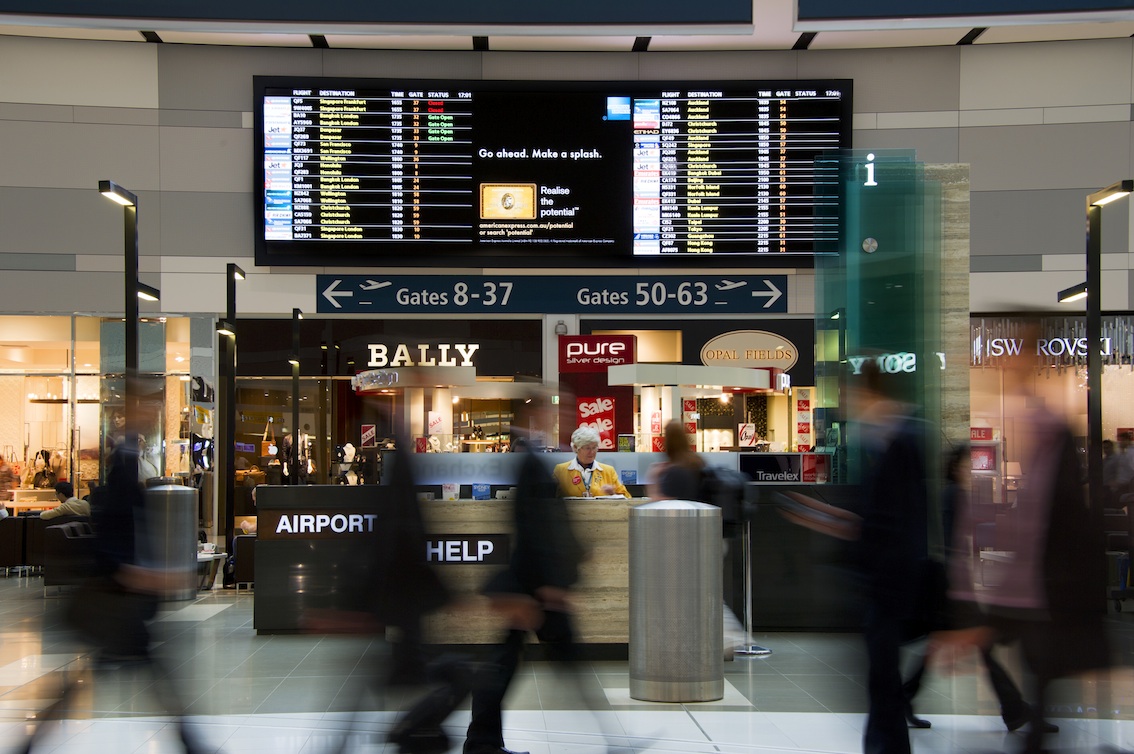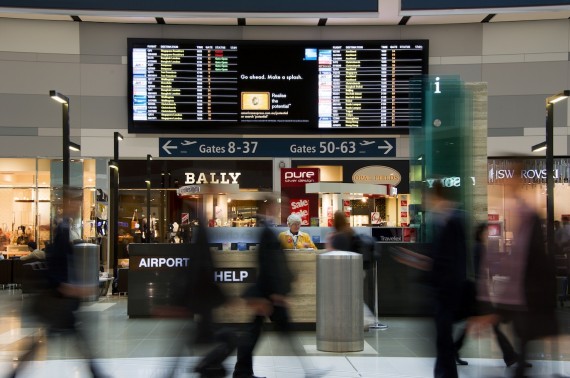From the moment you start daydreaming about that holiday, to getting yourself comfortable in seat 29E, Sydney Airport wants to join you on a digital journey.
Story: Christopher Holder
Much as changed since we last checked in with Sydney Airport (Issue 1).
The Airport has identified all of the customer touchpoints and has closed the loop to ensure it’s providing relevant content and information all the way from initial web enquiry to boarding the plane, and offering advertisers more precisely-targeted opportunities to communicate with travellers. Naturally, this means more than flicking an ad on a screen between departure times in the terminal.
Here’s how Martin Salter, Sydney Airport’s Manager Advertising and New Media, puts it: Since we last spoke we’ve really focussed on delivering a holistic media solution which encapsulates digital signage, mobile and content, and really focuses on delivering high-level engagement with our customers through the travel cycle.
TRAVEL CYCLE
Okay, back up a bit. Martin’s reference to a “holistic media solution” through the “travel cycle” may require further explanation. For starters, disabuse yourself of the notion that people go to an airport website to confirm flights, and look at airport screens to find the right gate to head to. We’re way beyond that. The travel cycle describes the ‘journey’ a customer goes on from initial daydreaming about a trip up until the point their told to buckle up and stow those tray tables.
Certainly, the ‘travel cycle’ starts a whole lot earlier than the moment a traveller makes it to the terminal.
Martin Salter: It starts during that initial research. If you’re looking to fly to Japan you’ll Google ‘events in Japan’ or ‘Sydney to Japan’. What we’re working on is to get Sydney Airport results at the top of the page so people will rely on the Airport site to review flights — who flies to Japan, and what times they fly. It means the Airport site will be a hub for planning a journey. Again, if it’s a Japan trip, our site will have content from the Japanese Tourism Organisation and other relevant information — what to do, events, accommodation.
From there you can use our website to book travel through our new booking engine, which you’ll find on our homepage. You can book accommodation, car hire and flights from there.
We’re building something that allows people to engage with the Sydney Airport site not just one day out, or one week or one month out but from the moment they’re daydreaming about the trip — the beginning of the travel cycle.

DigitalSignage: I’ve booked my flights through the Sydney Airport site. What next?
Martin Salter: People will log-on to the site to double-check details such as parking, transport, what they can and can’t pack etc. This is all on the site. Normally people will then confirm their flight the day before. So if they’re travelling with family they will be presented with different options relevant to travelling with children. When they arrive at the airport the following day, that’s where the Sydney Airport app really starts coming into its own.
DigitalSignage: This is the big news: the new app.
Martin Salter: Yes, it’s only been recently launched. And the idea has stemmed from first principles: how we engage with customers from a digital standpoint. We launched our free wifi network in 2010 and observed that the proportion of people accessing the network with a mobile device had risen from 35% to 86% in 12 months — a staggering increase. This was crucial data, but ultimately we wanted to provide travellers with contextual information. And by ‘contextual’ I mean, regardless of whether people were on their smartphone, tablet, laptop, or whether or not they were sitting at our gate lounge, they would be able to have access to information and content based on their destination.
DigitalSignage: What sort of information?
Martin Salter: You can opt into a service that sends notifications to your device rather than looking at the public flipscreens, and it will provide notifications and updates on the flight and destination that you’re flying to live to your phone. And we find that these notifications have a 25% open rate, which from a digital point of view is fantastic.
DigitalSignage: Okay, so my phone is telling me to ‘go to gate’. What next?
Martin Salter: Once people have spent around 60 minutes in our retail areas they then spend another 45 minutes at our gate lounge, and that’s where we’ve integrated our new booking engine on the digital screens. If you’re flying to London you’ll see hotel rates to the U.K., for example. And the traveller can use their smartphone to book additional travel or rental cars etc.
DigitalSignage: It’s comparatively easy to send personalised content to a customer’s device. How did you go with being more ‘contextual’ with your public displays?
Martin Salter: It’s about the destination and the integration we have with our flight information software. This is what we’re doing at our departure gates. I mentioned the car hire and accommodation examples, but our launch partner is Travelex, and what Travelex has done as part of its sponsorship on the mobile was to send a notification when you enter the terminal saying ‘don’t forget to top up your $US’, if you’re flight is to L.A., for example. And when you accept that message it will take you to a map and show you where those Travelex stores are in the terminal. The next step is internal GPS mapping, so our app can act as a wayfinding device throughout the terminal. That’s on the drawing board.
DigitalSignage: Which I’m guessing serves a practical purpose for the customer but also allows you to target the message even further?
Martin Salter: Wayfinding is very, very important in airports and it’s something that people constantly require. And if the technology is there for us to assist people finding their way around the airport and to their gate so they get there on time, then that’s obviously a good thing.
DigitalSignage: It sounds like the free wi-fi is the hook.
Martin Salter: It’s enormously popular. We use the digital signage to advertise our free wifi, and the uptake has been amazing. When we started we expected to deliver about 30,000 sessions a month, but because it’s such a good service and it’s completely free and unrestricted, we’re delivering well over 300,000.
After people register to use the free wifi, they go online and our website is the first page they see. They can be presented with information about the destination they’re flying to. We understand that the majority of people use our Wi-Fi to do voice calls through Skype, and Facetime on iPhones, but many people will be interested in downloading our app.
DigitalSignage: Are the airport retailers feeling the benefit of this app development?
Martin Salter: One of the nice pieces of integration we’ve done is with iOS Passbook. You can go online to our site and download a retail offer and that will pop up in their Passbook when they arrive at the airport and they can redeem that voucher onsite.
So we’re starting to work with retailers on implementing those types of opportunities. Passbook is still quite new to people, and Google Wallet, which should be coming soon. It’s in its infancy but already retailers are seeing the possibilities and starting down that path with us.
RULES OF ENGAGEMENT
It’s fascinating to see how Martin and his team have identified ways in which to make Sydney
Airport digitally indispensable. Traditionally, an airport website might be only used the day prior to departure to confirm a flight. The Airport has identified that necessity and turned the site into a portal. Not only that, but a means by which to introduce you to an app that will turn your smartphone into an indispensable device to navigate the usual airport gotchas, as well as introduce you to exclusive retail deals.
Martin Salter: The key is being there during the planning phase of your trip. And that’s why we have a whole section dedicated to it on the site. Booked foreign currency? Know what the rates are? Can you buy travel insurance at the airport? Can we assist you in getting the best car rental rates overseas? If we can be the first contact point for the passenger – and I think it makes sense that we are — then it’s worth having those features on our website.
————
THE BACK END
Sydney Airport needed a powerful, adaptable digital signage platform to keep pace with the changing scope of the system. Scala (supported by TechMedia) has been a key part of the omni-channel strategy of the digital team. Commonality of content across web, mobile and digital signage, sharing of data feeds, integration into flight systems and destination-based
offers targeting customers at a specific gate with live information isn’t something you can achieve without a powerful engine and knowledgable support.
TechMedia (Scala): (02) 9526 7880 or www.connectedsignage.com.au
LG Electronics (Displays): (02) 8805 4409 or www.lg.com.au


